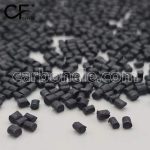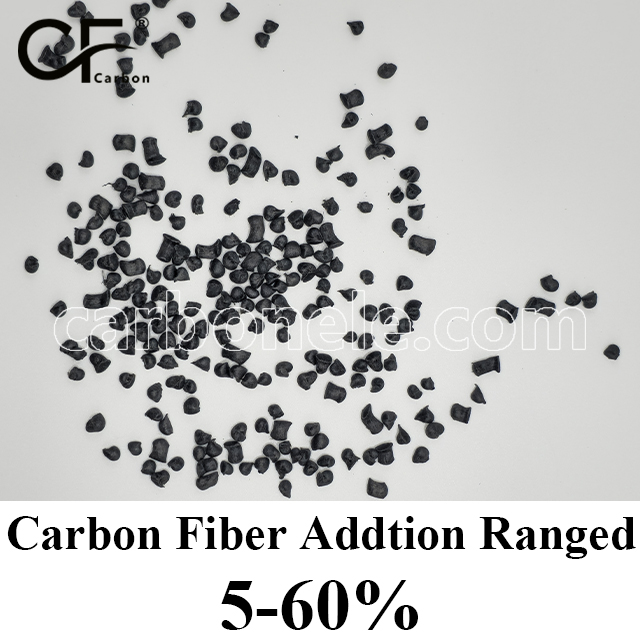
High-Performance PP-CF60 Carbon Fiber Composite
PP-CF60 is a high-performance carbon fiber composite featuring 60% carbon fiber reinforcement in polypropylene. This innovative material offers exceptional strength and stiffness while remaining lightweight, making it ideal for demanding applications in automotive, aerospace, and industrial sectors. With excellent thermal stability and chemical resistance, PP-CF60 maintains its performance in challenging environments. Perfect for structural components, enclosures, and machinery parts, it combines durability with versatility, meeting the rigorous demands of modern engineering and design.
- Model number: PP-CF-BCA6
- Matrix Resin: Polypropylene (PP)
- Reinforcing Filler: Carbon fiber
- Appearance: Granules
- Grade: Injection/extrusion grade
- Packaging: 25kgs/bag
Introduction to PP-CF60:
Polypropylene (PP) reinforced with 60% carbon fiber, also known as PP CF60, is a significant improvement in composite material technology. This high-performance composite combines the lightweight and adaptable properties of polypropylene with the superior strength and stiffness provided by carbon fibers. As industries seek materials that improve performance while reducing weight, PP CF60 has emerged as a top contender for a wide range of applications across numerous sectors.
PP-CF60 Composition and Properties
PP-CF60 is composed of polypropylene, a thermoplastic polymer recognized for its chemical resistance, low density, and excellent processability. The incorporation of 60% carbon fibers transforms this material into a composite exhibiting remarkable mechanical properties. Key features of PP CF60 include:
High Strength and Stiffness: The substantial proportion of carbon fibers significantly enhances both tensile and flexural strength within the composite structure. Consequently, PP CF60 is well-suited for applications requiring materials capable of enduring heavy loads and stresses without deformation.
Lightweight: Despite its enhanced strength profile, PP CF60 remains lightweight—a critical attribute in industries such as automotive and aerospace where reducing weight is essential for improving fuel efficiency.
Thermal Stability: This composite demonstrates commendable thermal stability, preserving its mechanical properties even at elevated temperatures. Such resilience allows it to be utilized in applications necessitating heat resistance.
Chemical Resistance: The intrinsic chemical resistance characteristic of polypropylene is retained in PP CF60, rendering it suitable for environments frequently exposed to various chemicals.
Low Creep Behavior: The integration of carbon fibers effectively mitigates creep under continuous loading conditions, ensuring that the material retains its shape and performance over time.
Applications of PP-CF60
Due to its exceptional properties, PP CF60 is utilized across various industries: Automotive Industry
The automotive sector significantly benefits from the use of PP CF60 in the production of lightweight yet durable components. It is commonly employed in structural parts, under-the-hood applications, and interior components where both strength and weight reduction are critical.
Aerospace: In aerospace applications, where weight savings can lead to substantial improvements in fuel efficiency, PP CF60 is used for interior components and structural elements that demand high strength-to-weight ratios.
Industrial Equipment: PP CF60 is particularly well-suited for manufacturing components in industrial machinery such as housings, brackets, and supports—areas where durability and mechanical performance are paramount.
Consumer Products: This material also finds application in a variety of consumer goods including sports equipment, protective gear, and high-performance household items, providing both durability and aesthetic appeal.
Electronics: Within the electronics industry, PP CF60 serves as an ideal choice for enclosures and structural components that require a combination of strength and thermal stability. This makes it suitable for a wide range of electronic devices.
Manufacturing and Processing
The processing of PP CF60 typically employs conventional plastic processing techniques such as injection molding, extrusion, and thermoforming. Due to its high carbon fiber content, specific adjustments may be necessary regarding processing parameters to ensure optimal material flow and performance. Advances in processing technology facilitate the efficient production of complex shapes and designs tailored to meet the diverse needs across various industries.
Conclusion
PP-CF60 is a high-performance composite material that combines the lightweight and adaptable properties of polypropylene with the superior strength and stiffness of carbon fibers. It is a top contender for various industries, such as automotive, aerospace, industrial equipment, consumer goods, and electronics. The composite’s composition includes polypropylene, a thermoplastic polymer known for its chemical resistance, low density, and excellent processability.
The addition of 60% carbon fibers enhances its strength and stiffness, making it suitable for applications requiring materials capable of enduring heavy loads and stresses without deformation. PP-CF60 remains lightweight, demonstrating commendable thermal stability, chemical resistance, and low creep behavior.
Its applications include the automotive industry, aerospace, industrial equipment, consumer goods, and electronics. Processing of PP-CF60 typically employs conventional plastic techniques, but specific adjustments may be necessary due to its high carbon fiber content.
If you want to get more information about PP-CF60, you can vist our Youtube.
Click here to contact us.
PP-CF60 granules
PP-CF60 granules are tiny pellets composed of polypropylene and five percent carbon fiber for reinforcement. The enhanced strength and rigidity offered by carbon fibers are combined with the lightweight and chemical-resistant qualities of polypropylene to create this composite material.



Frequently Asked Questions
Carbon (Xiamen) New Material Co., Ltd. aims to provide buyers with "one-stop" worry-free high-quality services. Here you can find all information about carbon fiber engineering plastics. If you still have questions, please send us an email for consultation!
-
How can I contact the manufacturer of a product that interests me?
When you find a product you are interested in, you can contact the manufacturer directly by sending an email and we will get back to you as soon as possible.
-
How do I find the products that interest me?
All you need to do is enter the keyword, product name in the search window and press the Enter key on your keyboard. Your search results page will then be displayed. You can also search within the product category pages on the home page. Each category is divided into subcategories, allowing you to refine your search and find products that interest you.
-
Where will I find a buying guide?
Please contact our after-sales service directly and we will provide you with a comprehensive operating guide.
-
What are CF Reinforced Thermoplastic Composites?
CF Reinforced Thermoplastic Composites are materials where carbon fibers are incorporated into a thermoplastic matrix. They combine the strength and stiffness of carbon fibers with the processability and recyclability of thermoplastics. For instance, they are used in automotive parts like bumper beams.
-
What are the benefits of CF Reinforced Thermoplastic Composites over traditional composites?
The key benefits include faster production cycles, easier recyclability, and better impact resistance. They also offer design flexibility. An example is in the manufacturing of consumer electronics casings where complex shapes can be achieved more easily.
-
How are CF Reinforced Thermoplastic Composites processed?
Common processing methods include injection molding, extrusion, and compression molding. Injection molding is widely used for mass production. For example, in the production of small components for the medical industry.
-
What industries use CF Reinforced Thermoplastic Composites?
They are utilized in aerospace, automotive, medical, and sports equipment industries. In aerospace, they can be found in interior components. In the medical field, they might be used in prosthetics.
-
How does the carbon fiber content affect the properties of the composites?
Higher carbon fiber content generally leads to increased strength and stiffness but may reduce ductility. A moderate content is often balanced for specific applications. For example, a higher content might be preferred in structural parts of a race car.
-
What are the challenges in using CF Reinforced Thermoplastic Composites?
Challenges include higher material costs, complex processing equipment requirements, and ensuring uniform fiber dispersion. Issues with adhesion between the fibers and the matrix can also arise. An example is in achieving consistent quality in large-scale production.


























